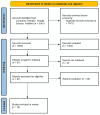Global Analysis of RTS, S/AS01 Malaria Vaccine Acceptance Rates and Influencing Factors: A Systematic Review
- PMID: 38899238
- PMCID: PMC11186483
- DOI: 10.7759/cureus.60678
Global Analysis of RTS, S/AS01 Malaria Vaccine Acceptance Rates and Influencing Factors: A Systematic Review
Abstract
Malaria remains a significant global health challenge, with Plasmodium parasites transmitted by Anopheles mosquitoes causing substantial morbidity and mortality. Despite historical efforts, malaria continues to affect millions worldwide, particularly in tropical regions. This systematic review aimed to assess the acceptability of the RTS, S/AS01 malaria vaccine among diverse populations. A comprehensive search strategy was employed across databases such as Cochrane Library, Embase, Google Scholar, and Medline. Studies were included based on specific criteria, including observational and cross-sectional designs involving adults. Data extraction and analysis were conducted meticulously, encompassing key variables related to vaccine acceptance rates and influencing factors. Analysis of 18 studies involving 18,561 participants revealed an overall malaria vaccine acceptance rate of 87.51%, ranging from 32.26% to 99.30%. Significant variations were observed based on demographics, with Ghana and Nigeria reporting high acceptance rates. Factors influencing acceptance included knowledge levels, past vaccination experiences, community preferences, and engagement in malaria prevention behaviors. Concerns about adverse reactions and regional disparities were noted as potential barriers to acceptance. This review highlights the importance of understanding public perceptions and concerns regarding malaria vaccines to enhance vaccine coverage and uptake. Tailored communication strategies, advocacy efforts, and targeted education interventions are crucial for addressing misconceptions and increasing vaccine acceptance. Policy recommendations should consider demographic and regional factors to ensure effective implementation of malaria vaccination programs, ultimately contributing to global malaria prevention efforts and public health initiatives.
Keywords: global health; malaria vaccine; public perceptions; vaccine acceptability; vaccine hesitancy.
Copyright © 2024, Ansar et al.
Conflict of interest statement
The authors have declared that no competing interests exist.
Figures
References
-
- Institute of Medicine (US) Committee on the Economics of Antimalarial Drugs. Committee on the Economics of Antimalarial Drugs. Saving Lives, Buying Time: Economics of Malaria Drugs in an Age of Resistance . Arrow KJ, Panosian. Vol. 7. Washington, D.C: National Academies Press (US); 2024. Saving Lives, Buying Time. Economics of Malaria Drugs in an Age of Resistance; p. 215624.
-
- Acceptance of malaria vaccine by a rural community in Nigeria. Ughasoro MD, Bisi-Onyemaechi AI, Okafor HU. Niger J Med. 2018;27:196–203.
Publication types
LinkOut - more resources
Full Text Sources
Miscellaneous

